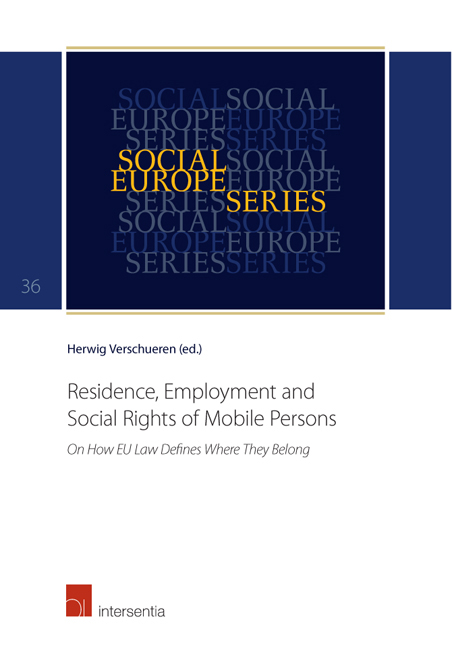Book contents
- Frontmatter
- Preface
- Contents
- List of Abbreviations
- List of Contributors
- Chapter 1 How EU Law Defines where Mobile Persons Belong. An Introduction
- Chapter 2 Family as Link. Explaining the Judicial Change of Direction on Residence Rights of Family Members from Third States
- Chapter 3 The Direction of the Court's Family Reunification Case-Law. A Plea for (Timely) Moderation
- Chapter 4 Sufficient Resources and Residence Rights under Directive 2004/38
- Chapter 5 Free Movement of Persons and European Solidarity. A Melancholic Eulogy
- Chapter 6 Once a Foreigner, Always a Foreigner. Who Does Not Belong Here Anymore? Expulsion Measures
- Chapter 7 Who Does Not Belong Here Anymore? A Statistical Snapshot of Member States’ Practices
- Chapter 8 Civic Integration Exams in EU Immigration Law. What Integration is Not in European Law
- Chapter 9 I Study Here, and Thus I Belong? Mobile Students in the European Union
- Chapter 10 Being Economically Active: How It Still Matters
- Chapter 11 Where Do EU Mobile Workers Belong, According to Rome I and the (E)PWD?
- Chapter 12 Conflicting Rules of Conflict: Social Security and Labour Law
- Chapter 13 Conflicting Rules of Conflict: Social Security and Labour Law. A Response
- Chapter 14 Where Does the UK Belong?
Chapter 3 - The Direction of the Court's Family Reunification Case-Law. A Plea for (Timely) Moderation
Published online by Cambridge University Press: 22 September 2018
- Frontmatter
- Preface
- Contents
- List of Abbreviations
- List of Contributors
- Chapter 1 How EU Law Defines where Mobile Persons Belong. An Introduction
- Chapter 2 Family as Link. Explaining the Judicial Change of Direction on Residence Rights of Family Members from Third States
- Chapter 3 The Direction of the Court's Family Reunification Case-Law. A Plea for (Timely) Moderation
- Chapter 4 Sufficient Resources and Residence Rights under Directive 2004/38
- Chapter 5 Free Movement of Persons and European Solidarity. A Melancholic Eulogy
- Chapter 6 Once a Foreigner, Always a Foreigner. Who Does Not Belong Here Anymore? Expulsion Measures
- Chapter 7 Who Does Not Belong Here Anymore? A Statistical Snapshot of Member States’ Practices
- Chapter 8 Civic Integration Exams in EU Immigration Law. What Integration is Not in European Law
- Chapter 9 I Study Here, and Thus I Belong? Mobile Students in the European Union
- Chapter 10 Being Economically Active: How It Still Matters
- Chapter 11 Where Do EU Mobile Workers Belong, According to Rome I and the (E)PWD?
- Chapter 12 Conflicting Rules of Conflict: Social Security and Labour Law
- Chapter 13 Conflicting Rules of Conflict: Social Security and Labour Law. A Response
- Chapter 14 Where Does the UK Belong?
Summary
AIM
This succinct contribution does not aim to engage with what one might call the ‘micro-electronics’ of the family reunification rules. The marvellous exposé of Daniel Thym, also contained in this volume, does a more than adequate job in that respect. Moreover, the present author wholeheartedly agrees with the gist – or perhaps one should say ‘essence’ or ‘Kernbereich’ – of his chapter. In a way, this short chapter serves to further buttress his conclusions. On the other hand, it posits an argument that travels along a distinctly different path. The focus lies on the underlying dynamics of the Court's family reunification caselaw, and consequently, the present chapter deals more with process than with substance. Said dynamics can be analysed (section 2) and critiqued (section 3). In equally traditional fashion, though often regarded symptomatic of the typical complacency of legal scholars, suggestions for improvement may be advanced, which here take the form of a plea for moderation (section 4).
ANALYSIS
Since the early 1960s, both the Community legislature and the Court have been almost relentlessly pushing the family reunification agenda. While at the time, the Parliament remained largely side-lined, the first batch of secondary instruments offers ample testimony of the Commission's and (to a lesser extent) the Council's great zeal. In supporting and occasionally leading the charge, however, the Court seems to have gotten caught up in its own systemic algorithm. In part, that entanglement appears to have spilled back into the legislative apparatus, particularly from the moment the Parliament became seriously involved. Thereby, the algorithm managed to acquire an apodictic credibility, without the original programming that fostered its development coming across as sufficiently sound.
Obviously, the preceding sentences beg for clarification. Let us first recall that at the inception of the Communities, family reunification rights were no component of the European integration franchise. Over time, beyond the economically active, the desire to include other persons entered into the main stream, leading to an expansion of the reach of EU law without proper premeditation.
- Type
- Chapter
- Information
- Residence, Employment and Social Rights of Mobile PersonsOn How EU Law Defines Where They Belong, pp. 39 - 46Publisher: IntersentiaPrint publication year: 2016

